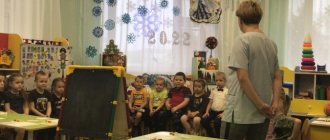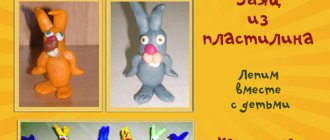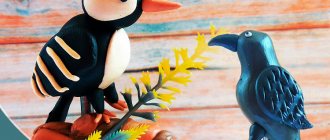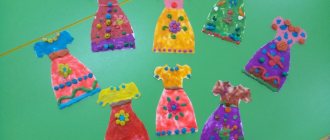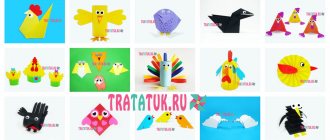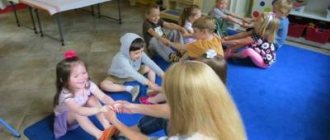Christmas tree
If the winter holidays are at stake, then green plasticine will come in handy for sculpting a Christmas tree. The corresponding process does not take much time:
- First, a large cone and a wide trunk are molded from green and brown plasticine;
- Next, the cone is placed on the barrel;
- The next step is to thin out the needle patterns from the very top to the bottom (for thinning, use the corner of a bank card or the edge of a coin);
- Small balls are rolled out from bright plasticine;
- Variegated toys are attached to the Christmas tree.
Basic construction skills in modeling classes
It is very useful to give children practical skills that can be useful to them in later adult life. For example, you can invite children to “build” a house. Modeling will also help you construct a building from plasticine logs, lay it out of bricks, or assemble it from solid “slabs.”
A lesson in a preparatory group with plasticine, which is based on the development of construction skills, can begin with the production of building materials: walls, bricks, logs. It is appropriate to use not only plasticine during “construction”, but also, for example, cellophane as glass, and use cardboard to imitate walls.
The benefits of practicing with plasticine
Modeling in the preparatory group helps to expand knowledge about the world around us, helps to form the first basic concepts about the physical properties of materials, the shapes of objects, and their colors.
The teachers always tell them something new about what they are going to ask the children to fashion. During the initial introductory speech, teachers involve the children themselves in the conversation. Thus, modeling in the preparatory group helps expand the vocabulary of children, teaches them to express their thoughts not only through created images, but also verbally.
During the work, various muscles of the fingers and hands are used, which later helps children learn to write without any problems during school. It has been noticed that those children for whom modeling in the preparatory group in a preschool institution and at home was a favorite activity, write at school much more accurately, smoothly and with more pleasure than those who neglected these activities.
An arm, a leg, a cucumber - here comes the little man!
The modeling of a person in the preparatory group can also be associated with the Dymkovo toy. It is best to start working with a female image, since a girl or “young lady” is usually depicted in a long dress reaching to the ground, which greatly simplifies the process. Clay should be used for production - this is the material that is traditional for Dymkovo toys. But there’s nothing wrong with trying your hand at using plasticine.
It is impossible to make a person realistically at this age. Therefore, you should not set impossible tasks for your kids. Let the man be “cartoonish”, completely different from the real one. It is important in this type of creativity to give the child the opportunity to fantasize using existing skills. Children really like to sculpt story compositions on the theme of famous cartoons and fairy tales - so let them create for their own pleasure!
Classes on working with clay, plasticine, and salt dough are fertile ground for raising a well-rounded personality. There is a place here for developing speech, and for replenishing vocabulary, and for gaining knowledge about the world around us and art. And, naturally, for the opportunity to realize creative potential.
"Plasticine" design
In addition to traditional creative tasks for creating three-dimensional figures, there are other ways to work with this magical material. For example, designing from plasticine parts is also modeling.
A lesson in the preparatory group on creating a car, bus, wheelbarrow for transporting soil, manure, bricks, helps kids learn the basics of constructing objects that move with the help of wheels. True, for such activities, little craftsmen will need axles to attach the wheels. These could be matches with broken sulfur tips, toothpicks with sharp ends ground off, or pieces of wire with twisted ends.
Plasticine modeling for children
Kids really like to create household items. Therefore, it makes sense to invite children to fashion doll furniture from plasticine: cribs, sofas, tables and chairs, armchairs and even a TV.
Modeling dolls from plasticine for children is fun and useful. Not only does the novice master create objects of various shapes, he is given the opportunity to decorate his own creations with ornaments using “plasticine drawing”. You can apply patterns using small balls, “sausages” - straight or curved. You can also decorate objects with relief, using pressure or by scratching the surface with a sharp stick or stick.
Autumn plasticine composition with mushrooms
Figure modeling is considered easier for children. Mushrooms in the preparatory group should be sculpted more naturalistically than in the middle and junior groups. You no longer need to limit yourself to bright fly agarics or boletus mushrooms with smooth, rounded caps.
Modeling “Mushrooms” in the preparatory group involves more diverse options: honey mushrooms, russula, chanterelles, saffron milk caps. Their hats have a variety of shapes. Some mushrooms should be sculpted from a single piece of plasticine, rather than attaching a separately made cap.
It is also interesting to show children the play of colors, in some cases even the transition of one shade to another. You should also draw the attention of novice sculptors to the fact that in nature the edges of mushroom caps can be uneven, as if slightly torn.
Plasticine paintings
Plasticine drawings are real masterpieces of children's creativity. The children really like to depict fairy tale plots and pictures of nature using this technique. The sculpture “Autumn” is interesting in this regard.
The kindergarten preparatory group can independently create a landscape using natural materials: colorful leaves, twigs to imitate tree trunks, plant seeds. Often cereals and pasta are used for this direction in artistic creativity.
Whistle, egg stand or pencil holder in the shape of a bird
During modeling classes, you can invite children to make a gift with their own hands, which their mother, grandmother, father, brother or sister will be pleased to receive. Modeling a bird is perfect for achieving this goal. In the preparatory group, it is extremely important to instill in children a sense of the significance of what they do, to connect their creativity with practical application in life. Therefore, you need to teach them to sculpt not just a bird, but, for example, a whistle or a pencil holder, an egg stand or a salt shaker.
For these purposes, you should use additional materials: a plastic cup, a whistle, an old salt shaker. The peculiarity of this type of creativity is that during the sculpting process the child takes some object as a basis and hides it with plasticine, giving it the shape of a bird. It is important to do this as carefully as possible, so that the necessary holes remain operational.
An interesting option in this type of creative activity could be modeling not from plasticine, but, for example, from salt dough, ordinary or polymer clay. You can bake (if necessary) finished products in a microwave oven in several stages, periodically removing the item and cooling it. In the microwave, you need to set the “defrost” mode to the minimum temperature and time of one minute. Then the thing will be able to serve for a long time without deforming. After hardening, the product will need to be painted and varnished - this can already be done in art classes.
Although children begin to sculpt birds in early childhood, more complex and important skills should be instilled in the preparatory group. It is very useful to teach children to give shape to the entire piece of the original material at once, and not to sculpt a head, tail, body separately and then connect everything together. Of course, not all children will learn this right away, but this goal should be set for them now. During the lesson, you can introduce students to Dymkovo toys and invite them to do work in this style.
Vegetables from plasticine
Getting to know the world around you is impossible without acquiring basic knowledge about plants. Activities involving working with plasticine are very effective in this regard. Modeling “Vegetables” in the preparatory group includes a conversation about what people grow in their dachas and gardens, which plants produce a harvest in the spring, which in the summer, and which fruits delight us in the fall.
In these classes, children should pay attention to the fact that vegetables differ in taste, method of application, amount of vitamins contained in them, and also emphasize how important it is for people to eat these gifts of nature.
In order to get a good result in classes on sculpting vegetables, it should be clarified that all vegetables have different shapes: round, flat, rounded, flattened, oval, with a sharp tip, with a notch in the place of the stalk, with grooves on the sides or with small pimples. It is also necessary to point out the color of the fruit, note that some vegetables are unevenly colored, have a white tip or stripes. During sculpting, you can suggest adding green parts of plants to the fruits themselves.
